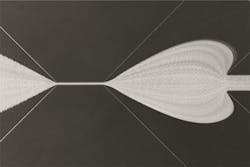Cytometry method enables mechanical screening of biological cells at unprecedented speed
A new cytometry approach for the mechanical characterization of cells, developed by scientists at the Dresden University of Technology (Dresden, Germany), has the potential to revolutionize the diagnosis of a wide range of diseases.
Related: Instrumentation advances add flexibility and quantitation to flow cytometry
So far, there has been a lack of an adequate method to mechanically screen large populations of cells in a short amount of time. Their small size poses a significant challenge for detailed mechanical characterization of single biological cells. Current methods available for such characterization are technically involved, difficult in their handling, and limited to small cell numbers and low measurement rates. But the research team, led by Professor Jochen Guck at the University's Biotechnology Center (BIOTEC), has now developed an innovative technology that addresses all these problems: Real-time deformability cytometry (RT-DC) enables continuous, on-the-fly mechanical screening of hundreds of cells per second, a method they claim is 10,000 times faster than previous methods.
In a study, the scientists demonstrated the mechanical fingerprinting of the different types of cells contained in a drop of blood within a few minutes. Due to the very high throughput of RT-DC, even white blood cells, which are greatly outnumbered by the red blood cells by roughly 1:1000, can be reliably characterized. This is important because white blood cells constitute an important part of the immune system. Any characteristic change in their mechanical fingerprint could someday be used by medical doctors for a faster and better quantitative assessment of the health of patients.
Through the University spinoff company ZellMechanik Dresden, the next step for the researchers is to distribute the RT-DC technology commercially to a wide range of university and industrial researchers. Their ultimate goal is the development and commercialization of a dedicated, stand-alone diagnostic device.
Full details of the work appear in the journal Nature Methods; for more information, please visit http://dx.doi.org/10.1038/nmeth.3281.
-----
Follow us on Twitter, 'like' us on Facebook, connect with us on Google+, and join our group on LinkedIn
Subscribe now to BioOptics World magazine; it's free!

